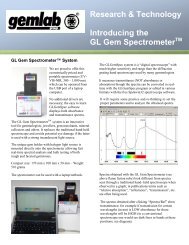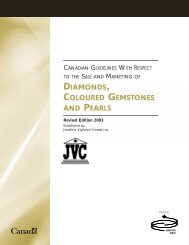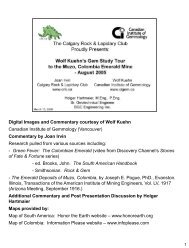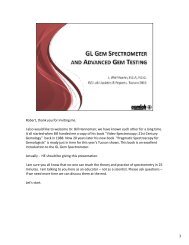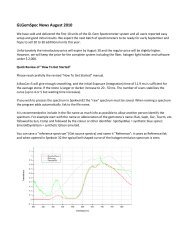JADEITE - Canadian Institute of Gemmology
JADEITE - Canadian Institute of Gemmology
JADEITE - Canadian Institute of Gemmology
Create successful ePaper yourself
Turn your PDF publications into a flip-book with our unique Google optimized e-Paper software.
in the cobalt content in the three categories <strong>of</strong> stone. Overall they characterize the stones in these<br />
categories as follows (page 43):<br />
The Motagua Light samples can be characterized as consisting <strong>of</strong> major abundances <strong>of</strong><br />
jadeite and albite, with occurrences <strong>of</strong> prargonite and analsite... The Motagua Dark<br />
specimens contain less abundant jadeite, major abundances <strong>of</strong> omphacite, and variable<br />
amounts <strong>of</strong> analcite. In contrast, the analyzed Maya Green samples possess abundant<br />
jadeite, trace omphacite, and relatively low abundances <strong>of</strong> albite, muscovite, and analcite.<br />
Data are provided about the chemical composition <strong>of</strong> a number <strong>of</strong> the stones belonging to these<br />
three categories (page 45). A sample <strong>of</strong> eight Motagua Light stones have the following<br />
characteristics: 58.91% Si0 2, 24.6% Al 2O 3, 12% Na 2O, 1.97% CaO, 1.29% MgO, 1.01% FeO, and<br />
traces <strong>of</strong> Cr 2O 3, K 2O, and MnO. A sample <strong>of</strong> seven Maya Green stones have the following<br />
characteristics: 57.5% Si0 2, 20.0% Al 2O 3, 10.7% Na 2O, 4.78% CaO, 3.84% MgO, 1.20% FeO,<br />
0.32% Cr 2O 3, and traces <strong>of</strong> K 2O and MnO. A sample <strong>of</strong> five Motagua Dark Omphacite stones have<br />
the following characteristics: 53.8% Si0 2, 14.4% Al 2O 3, 6.2% Na 2O, 10.36% CaO, 7.46% MgO,<br />
2.32% FeO, 0.10% Cr 2O 3, and traces <strong>of</strong> K 2O and MnO.<br />
On the basis <strong>of</strong> electron beam microprobe analysis the authors plot the relative jadeite<br />
composition in the various samples (see fig. 2.3, page 49). Among the findings is that: "The Costa<br />
Rican Light specimens all lie near the pure jadeite corner, and the Maya Green are close to the<br />
jadeite-omphacite boundary." Chichén Green falls in between. Later in their chapter (page 58), the<br />
authors discuss the distinctiveness <strong>of</strong> the Costa Rican samples, which have a tendency towards a<br />
bluish-green color (like the so-called Olmec pieces), from those found elsewhere. Their<br />
distinctiveness mineralogically is related to "the virtual absence <strong>of</strong> mica and the low albite content in<br />
the Costa Rican specimens."<br />
Tests. Let us now turn to some <strong>of</strong> the tests that can be used to identify jadeite. Hobbs (1982)<br />
lists several tests: visual examination, refractive index readings, specific gravity determination,<br />
spectroscopic analysis, hardness tests, and X-ray diffraction. To this could be added the use <strong>of</strong> a<br />
Chelsea filter. In regard to the latter, it is interesting to note that while green jadeite's color is derived<br />
from the presence <strong>of</strong> chromium, it "does not show red under the Chelsea filter, nor does it do so<br />
under either LW or SW UV light" (Field 2000: 3). Under long-wave ultra-violet light "the paler<br />
coloured green and the yellow, mauve and white jadeite shows a whitish glow <strong>of</strong> low intensity, the<br />
darker coloured jadeite being unresponsive." Among the tests discussed by Hobbs, we will review<br />
all except for hardness tests since such tests are rarely used for jadeite. Hobbs (1982: 18) indicates<br />
that such tests are not very useful for jadeite and "would only help separate materials that have a<br />
hardness value that is significantly lower than jade, such as serpentine, calcite, and talc."<br />
Turning first to visual examination, Hobbs (1982: 6-7) remarks:<br />
17




